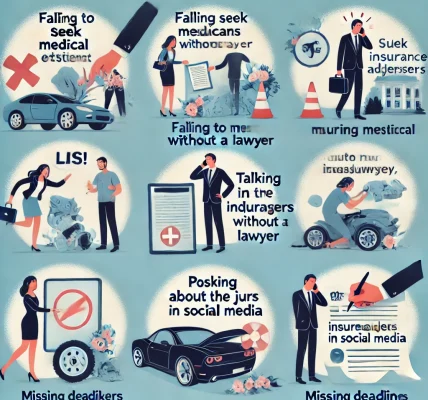Introduction
Personal injury claims aim to compensate victims for injuries caused by accidents, but what happens if the victim already had a pre-existing condition? Insurance companies often scrutinize such cases, arguing that the injuries were not solely caused by the accident. Understanding how pre-existing conditions impact personal injury settlements can help claimants navigate the process and maximize their compensation.
This guide will explain the legal aspects of pre-existing conditions in personal injury cases, strategies to strengthen your claim, and common pitfalls to avoid.
What is a Pre-existing Condition?
A pre-existing condition refers to any injury, illness, or medical condition that existed before the accident occurred. Common examples include:
- Chronic pain conditions (e.g., arthritis, back pain)
- Previous injuries (e.g., a prior broken bone, whiplash from a past accident)
- Degenerative diseases (e.g., osteoporosis, herniated discs)
- Mental health conditions (e.g., PTSD, anxiety, depression)
While these conditions predate the accident, they do not eliminate your right to compensation. Instead, the challenge is proving that the accident worsened the pre-existing condition or caused new injuries.
The “Eggshell Plaintiff” Doctrine
The Eggshell Plaintiff Doctrine is a legal principle that protects individuals with pre-existing conditions. It states that a defendant must take the victim as they find them, meaning they are responsible for any additional harm caused by their negligence, even if the victim was more vulnerable due to a pre-existing condition.
For example, if someone with a fragile spine sustains a severe back injury in a car accident, the at-fault party is still responsible for the full extent of the new injuries, even though the victim was predisposed to back issues.
Challenges Insurance Companies May Present
Insurance companies often try to reduce settlement amounts by arguing that:
- Your injuries were pre-existing and not related to the accident.
- The accident did not significantly worsen your condition.
- Your medical treatment is excessive given the nature of the accident.
How to Counter These Arguments:
- Medical Records: Providing past and current medical records can demonstrate how the accident worsened your condition.
- Expert Testimony: Doctors or specialists can provide statements proving that your injuries are aggravated due to the accident.
- Consistent Treatment: Following a clear treatment plan reinforces the legitimacy of your claim.
Steps to Strengthen Your Claim
If you have a pre-existing condition and are filing a personal injury claim, follow these key steps to improve your chances of receiving fair compensation:
1. Disclose Your Pre-existing Condition Honestly
- Never attempt to hide a past injury or medical issue.
- Transparency strengthens your credibility and prevents insurers from arguing fraud.
2. Gather Strong Medical Evidence
- Obtain medical records from before and after the accident.
- Have your doctor provide a written statement explaining how the accident affected your condition.
- Diagnostic tests (X-rays, MRIs, CT scans) can serve as evidence of worsening injuries.
3. Follow Your Treatment Plan
- Attend all medical appointments and follow your doctor’s recommendations.
- Keep records of all treatments, medications, and therapy sessions.
4. Avoid Social Media Discussions
- Insurance adjusters may monitor your social media activity.
- Avoid posting anything that could undermine your claim (e.g., engaging in physical activities that contradict your injury claims).
5. Hire a Personal Injury Attorney
- An experienced attorney can negotiate with insurance companies and refute attempts to minimize your claim.
- They can gather expert witnesses and medical professionals to support your case.
How Pre-existing Conditions Affect Compensation
Having a pre-existing condition does not mean you won’t receive compensation. However, the settlement amount may depend on the extent of new injuries and the impact on your existing condition.
Two Key Factors in Compensation Calculations:
- Aggravation of Pre-existing Condition: You may receive compensation for any additional pain, treatment, or disabilities caused by the accident.
- New Injuries: If the accident caused entirely new injuries, you can claim full compensation for those damages.
Types of Compensation Available:
- Medical expenses (past, present, and future treatment)
- Lost wages (due to inability to work)
- Pain and suffering (physical and emotional distress)
- Loss of quality of life (if the accident significantly impacts daily activities)
Common Mistakes to Avoid
1. Failing to Seek Immediate Medical Attention
Delaying treatment can allow insurance companies to argue that your injuries were unrelated to the accident.
2. Not Keeping Detailed Records
Medical bills, doctor’s notes, and prescriptions should all be documented to support your claim.
3. Accepting the First Settlement Offer
Insurance companies often make lowball offers, especially when a pre-existing condition is involved. Consult an attorney before accepting any settlement.
4. Providing Inconsistent Statements
Ensure that all statements given to medical providers, insurers, and legal representatives are consistent to avoid claim denial.
Conclusion
A pre-existing condition should not prevent you from receiving fair compensation for injuries caused by an accident. While insurance companies may try to minimize payouts, understanding your rights, gathering strong medical evidence, and working with an experienced attorney can help you secure the settlement you deserve.
By being proactive, transparent, and well-prepared, you can effectively counter insurance tactics and receive the compensation needed to recover and move forward with your life.




